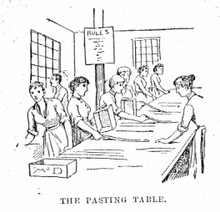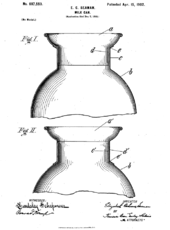At birth she was named Elizabeth Jane Cochran. She was born in "Cochran's Mills", now part of the Pittsburgh suburb of Burrell Township, Armstrong County, Pennsylvania. Her father, Michael Cochran, born about 1810, started out as a laborer and mill worker before buying the local mill and most of the land surrounding his family farmhouse. He later became a merchant, postmaster, and associate justice at Cochran's Mills (which was named after him) in Pennsylvania. Michael married twice. He had 10 children with his first wife, Catherine Murphy, and 5 more children, including Elizabeth, with his second wife, Mary Jane Kennedy. Michael Cochran's father had immigrated from County Londonderry, Ireland in the 1790s.
As a young girl Elizabeth often was called "Pinky" because she so frequently wore that color. As she became a teenager she wanted to portray herself as more sophisticated, and so dropped the nickname and changed her surname to "Cochrane". She attended boarding school for one term, but after her father's death in 1870 or 1871, was forced to drop out due to lack of funds.
In 1880 Cochrane's mother moved her family to Pittsburgh. A newspaper column entitled "What Girls Are Good For" in the Pittsburgh Dispatch that reported that girls were principally for birthing children and keeping house prompted Elizabeth to write a response under the pseudonym "Lonely Orphan Girl". The editor, George Madden, was impressed with her passion and ran an advertisement asking the author to identify herself. When Cochrane introduced herself to the editor, he offered her the opportunity to write a piece for the newspaper, again under the pseudonym "Lonely Orphan Girl". Her first article for the Dispatch, entitled "The Girl Puzzle", was about how divorce affected women. In it, she argued for reform of divorce laws. Madden was impressed again and offered her a full-time job. It was customary for women who were newspaper writers at that time to use pen names. The editor chose "Nellie Bly", adopted from the title character in the popular song "Nelly Bly" by Stephen Foster. Cochrane originally intended that her pseudonym be "Nelly Bly", but her editor wrote "Nellie" by mistake and the error stuck.
Career
Pittsburgh Dispatch
As a writer, Bly focused her early work for the Pittsburgh Dispatch on the lives of working women, writing a series of investigative articles on women factory workers. However, the newspaper soon received complaints from factory owners about her writing, and she was reassigned to women's pages to cover fashion, society, and gardening, the usual role for women journalists, and she became dissatisfied. She then traveled to Mexico to serve as a foreign correspondent. Still only 21, she spent nearly half a year reporting the lives and customs of the Mexican people; her dispatches later were published in book form as Six Months in Mexico.[13] In one report, she protested the imprisonment of a local journalist for criticizing the Mexican government, then a dictatorship under Porfirio Díaz. When Mexican authorities learned of Bly's report, they threatened her with arrest, prompting her to flee the country. Safely home, she accused Díaz of being a tyrannical czar suppressing the Mexican people and controlling the press.
Asylum exposé
Burdened again with theater and arts reporting, Bly left the Pittsburgh Dispatch in 1887 for New York City. Penniless after four months, she talked her way into the offices of Joseph Pulitzer's newspaper the New York World, and took an undercover assignment for which she agreed to feign insanity to investigate reports of brutality and neglect at the Women's Lunatic Asylum on Blackwell's Island.
Committed to the asylum, Bly experienced the deplorable conditions firsthand. After ten days, the asylum released Bly at The World's behest. Her report, later published in book form as Ten Days in a Mad-House, caused a sensation, prompted the asylum to implement reforms, and brought her lasting fame.
Around the world
In 1888 Bly suggested to her editor at the New York World that she take a trip around the world, attempting to turn the fictional Around the World in Eighty Days into fact for the first time. A year later, at 9:40 a.m. on November 14, 1889, and with two days' notice, she boarded the Augusta Victoria, a steamer of the Hamburg America Line, and began her 40,070 kilometer journey.
She took with her the dress she was wearing, a sturdy overcoat, several changes of underwear, and a small travel bag carrying her toiletry essentials. She carried most of her money (£200 in English bank notes and gold, as well as some American currency) in a bag tied around her neck.
The New York newspaper Cosmopolitan sponsored its own reporter, Elizabeth Bisland, to beat the time of both Phileas Fogg and Bly. Bisland would travel the opposite way around the world, starting on the same day as Bly took off. To sustain interest in the story, the World organized a "Nellie Bly Guessing Match" in which readers were asked to estimate Bly's arrival time to the second, with the Grand Prize consisting at first of a free trip to Europe and, later on, spending money for the trip.
During her travels around the world, Bly went through England, France (where she met Jules Verne in Amiens), Brindisi, the Suez Canal, Colombo (Ceylon), the Straits Settlements of Penang and Singapore, Hong Kong, and Japan. The development of efficient submarine cable networks and the electric telegraph allowed Bly to send short progress reports, although longer dispatches had to travel by regular post and thus were often delayed by several weeks.
Bly travelled using steamships and the existing railroad systems, which caused occasional setbacks, particularly on the Asian leg of her race.[27] During these stops, she visited a leper colony in China and, in Singapore, she bought a monkey.
As a result of rough weather on her Pacific crossing, she arrived in San Francisco on the White Star Line ship RMS Oceanic on January 21, two days behind schedule. However, after World owner Pulitzer chartered a private train to bring her home, she arrived back in New Jersey on January 25, 1890, at 3:51 pm.
Just over seventy-two days after her departure from Hoboken, Bly was back in New York. She had circumnavigated the globe, traveling alone for almost the entire journey. Bisland was, at the time, still crossing the Atlantic, only to arrive in New York four and a half days later. She also had missed a connection and had to board a slow, old ship (the Bothnia) in the place of a fast ship (Etruria). Bly's journey was a world record, although it was bettered a few months later by George Francis Train, whose first circumnavigation in 1870 possibly had been the inspiration for Verne's novel. Train completed the journey in 67 days, and on his third trip in 1892 in 60 days. By 1913, Andre Jaeger-Schmidt, Henry Frederick, and John Henry Mears had improved on the record, the latter completing the journey in fewer than 36 days.
Later work
In 1904 Iron Clad began manufacturing the steel barrel that was the model for the 55-gallon oil drum still in widespread use in the United States. Although there have been spurious claims that Bly invented the barrel, the actual inventor is Henry Wehrhahn. (U.S. Patents 808,327 and 808,413).
Bly was, however, an inventor in her own right.
Personal life and death
In 1895, Bly married millionaire manufacturer Robert Seaman. Bly was 31 and Seaman was 73 when they married. Due to her husband's failing health, she retired from journalism and succeeded her husband as head of the Iron Clad Manufacturing Co., which made steel containers such as milk cans and boilers. In 1904, Seaman died.
Bly died of pneumonia at St. Mark's Hospital in New York City in 1922 at age 57. She was interred in a modest grave at Woodlawn Cemetery in The Bronx, New York City.
Seven years later, Elizabeth Bisland, an American journalist and author, perhaps best known for her 1889–1890 race around the world against Nellie Bly, also died of pneumonia, and she was buried in the same cemetery.







No comments:
Post a Comment